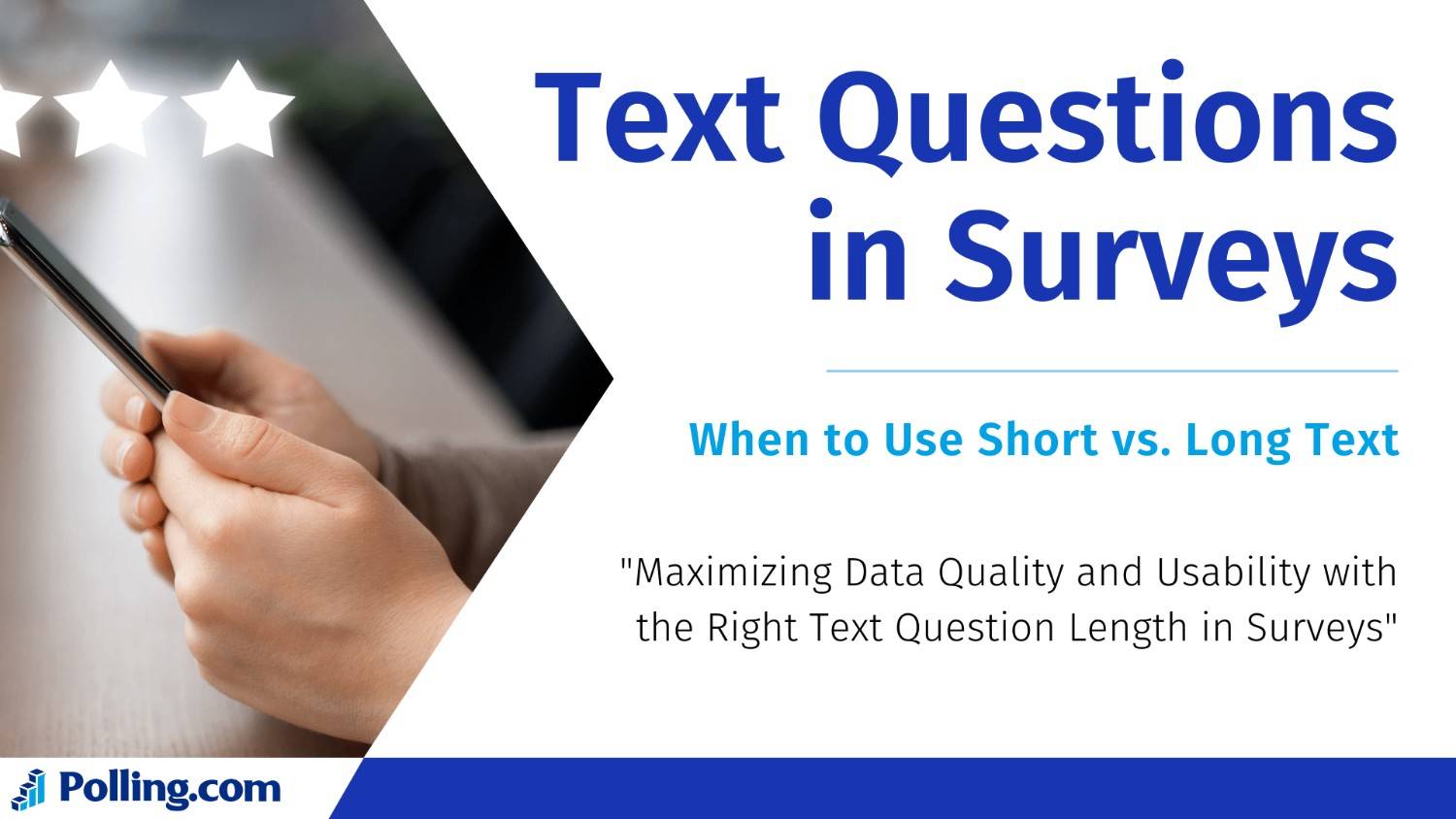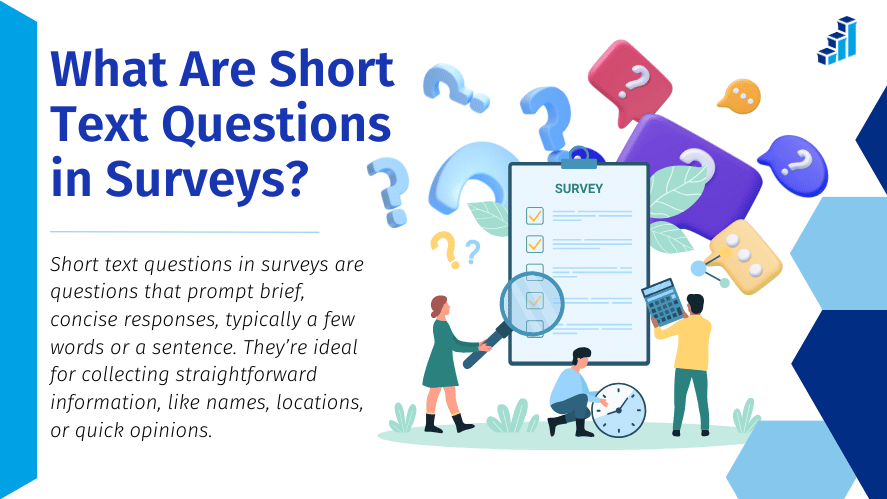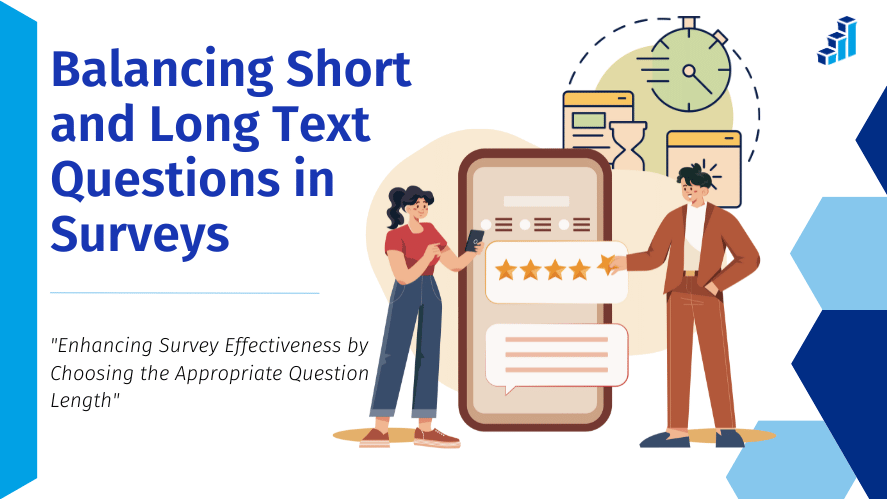
Text Questions in Surveys: When to Use Short vs. Long Text
Text questions in surveys play a major role in the quality of feedback you receive. Choosing the right question types can greatly impact both the response rate and the depth of information you collect. Two common types of open-ended questions short text and long text questions each serve different purposes and can shape the data you gather in unique ways. Knowing when to use each type helps ensure your survey is both effective and engaging.
Two popular types of questions are short text questions and long text questions. Short text questions are for quick, simple answers, while long text questions allow people to give more detail. Knowing when to use each one can make a big difference in the quality of information you get. At Polling.com, we provide tools to help you make effective surveys. Let’s explore when to use short and long text questions and how to balance them.
What Are Short Text Questions in Surveys?

Definition
Short text questions are a type of open-ended question that asks for brief answers. Respondents usually answer in one or two words, a short phrase, or a number. These questions are simple and straightforward.
Examples of Short Text Questions
Here are some examples of short text questions:
- “What is your favorite color?”
- “How old are you?”
- “What is your job title?”
- “What is your ZIP code?”
Advantages of Short Text Questions
- Quick to Answer: Short text questions require very little typing, so they are fast to complete. This can help reduce survey fatigue.
- Simple Data Collection: These questions are great for gathering specific information, like names, ages, or preferences.
- Easy to Analyze: Since the answers are short, it’s easier to categorize or count them.
Disadvantages of Short Text Questions
- Limited Detail: Short text questions don’t allow people to give detailed answers. You won’t get much context or explanation.
- Risk of Vague Responses: Sometimes, a short answer isn’t enough to understand what the respondent really means.
Short text questions are best when you need specific facts or short answers. They’re perfect for gathering simple information without taking up much time.
What Are Long Text Questions in Surveys?
Definition
Long text questions are open-ended questions that give respondents space to provide more detailed answers. These questions encourage people to explain their thoughts, share experiences, or give detailed feedback.
Examples of Long Text Questions
Examples of long text questions include:
- “Please describe your experience with our product.”
- “What suggestions do you have for improving our services?”
- “Why did you choose our company over others?”
- “How can we better meet your needs?”
Advantages of Long Text Questions
- Rich Data: Long text questions let respondents share more details. This can help you understand the reasons behind their answers.
- Qualitative Feedback: These questions are good for gathering opinions, suggestions, or personal stories.
- Nuanced Responses: Respondents can share more complex thoughts and ideas.
Disadvantages of Long Text Questions
- Takes Longer to Complete: Long text questions require more time to answer, which may discourage some respondents.
- Harder to Analyze: With long answers, it takes more effort to review and interpret the data. You may need extra tools or time to analyze the text.
Long text questions are best when you need in-depth answers or when you want to understand experiences, opinions, or ideas.
When to Use Short Text Questions in Surveys

Situations for Use
Short text questions are best for collecting simple and direct information. Here are some good times to use them:
- Demographic Data: If you’re asking about age, location, or job title, short text questions are a good fit.
- Factual Information: For quick details like a ZIP code or favorite product, short text questions work well.
- Quick Responses: When you want answers that don’t require much thought, short text questions are ideal.
Best Practices for Short Text Questions
- Start with Short Text Questions: Begin your survey with easy, short questions to get people comfortable.
- Mix with Multiple-Choice Questions: Use short text questions along with multiple-choice questions to make the survey flow better.
- Avoid Overuse: Too many short text questions in a row can make the survey feel rushed or shallow. Mix them with other question types.
By using short text questions wisely, you can keep the survey quick and focused while gathering essential data.
When to Use Long Text Questions in Surveys
Situations for Use
Long text questions are great for getting detailed feedback. Use them when you want respondents to explain their answers in more depth:
- Customer Experience: Ask for details about customer satisfaction or product feedback.
- Suggestions and Recommendations: Long text questions are perfect for asking respondents how you can improve.
- Complex Topics: When exploring more complex subjects, long text questions give people room to explain their thoughts.
Best Practices for Long Text Questions
- Use Sparingly: Don’t use too many long text questions in one survey, or it may feel overwhelming.
- Frame the Question Clearly: Make sure respondents know what kind of answer you’re looking for. For instance, rather than asking ‘Tell us about your experience,’ consider asking ‘Can you describe any difficulties you encountered while using our product?”
- Prepare for Analysis: Long text responses can be harder to analyze. If you expect a lot of detailed answers, consider using tools to help with text analysis.
Using long text questions sparingly helps you gather valuable insights without overwhelming your respondents.
Balancing Short and Long Text Questions in Surveys

Combining for Better Results
Using a mix of short and long text questions can help you get both quick data and detailed feedback. A balanced survey keeps people engaged without being too demanding. You get both the numbers (quantitative data) and the stories (qualitative data) that add meaning to those numbers.
Use Case Examples
Imagine a customer feedback survey. You could start with short text questions to collect demographic information, then add long text questions for detailed feedback. This approach gives you a mix of factual data and personal insights.
Optimizing User Experience
Survey flow is important. If you ask too many long questions in a row, people may get tired. If you ask too many short questions, the survey might feel too simple. A well-designed survey has a good mix, which keeps respondents interested and encourages thoughtful answers.
Conclusion
Choosing the right question type in a survey isn’t just about what data you want. It’s also about how you want to gather that data. Short text questions work well for simple, direct answers. Long text questions are great for gathering detailed feedback and opinions. By using both types wisely, you can create surveys that are effective and engaging.
At Polling.com, we offer survey tools that help you pick the best question formats for your needs. Whether you want quick polls or detailed feedback, our tools make it easy to design surveys that work. Explore Polling.com’s survey tools today to start making better surveys and collecting valuable insights.
